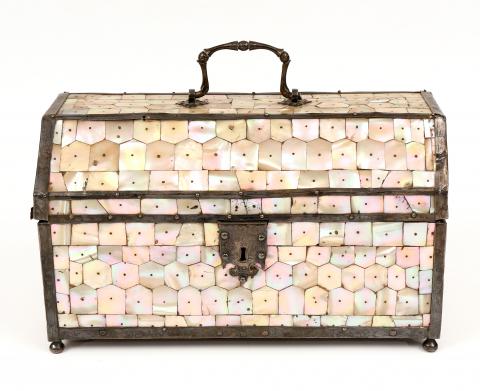Cofre
Casket
Teak, mother-of-pearl and fabric
Silver mountings
Gujarat, India, late 16th to early 17th century
Dim.: 14.0 × 25.0 × 13.0 cm
Cofre
Teca, madrepérola e tecido; montagens em prata
Guzarate, Índia
Séculos XVI (finais) a XVII (inícios)
14 x 25 x 13 cm
A rare and important rectangular box with a truncated pyramidal lid (with slopes on each side and a flat top), one of the European typologies of caskets most copied by Gujarati, both in objects covered with mother-of-pearl mosaic - from the marine gastropod Turbo marmoratus and also from local pearl oyster species.
The mounts, silver straps or bands delicately chased with Renaissance-style floral motifs in arabesque, cover all the edges of the casket and are pinned to the structure with small decorative silver nails. The escutcheon-shaped lockplate is decorated with floral scrolls. One of the most curious aspects of the chased decoration is the presence of small monograms, combining the capital letters "O" and "I" (possibly the initials of the couple who owned it), alternating with intertwined hearts, pointing to the clear nuptial function of these kind of caskets, used as a jewellery boxes. The Iberian Renaissance-style broken-shaped cast handle is decorated with with small acanthus leaves, while the unadorned crenelated hinges are pinned with large silver nails.
The Indian origin of this production, namely from Cambay and Surat in the present state of Gujarat is fully demonstrated, not only by ample documentary evidence but also by the survival of sixteenth-century wooden structures covered in mother-of-pearl tesserae. Basins, salvers, plates, cups, bottles, jugs and ewers were produced from mother-of-pearl modelled after European prototypes in tin or silver brought by the first Portuguese to reach the west coast of India, not unlike the caskets which imitate well-known European models, namely French cuir bouilli caskets with truncated pyramidal lids such as the present example. The mother-of-pearl tesserae were pinned and glued to each other with brass pins (but also of iron or silver), sometimes with inner brass bands that served as a structure for the placing of tesserae on either side in the case of three-dimensional pieces - or to a wooden structure, in the case of larger plates and salvers, and small caskets.
Made to Portuguese order for export to Europe, the first examples to arrive in Lisbon were certainly destined for the royal court and the princely collections of the time, as was recorded in surviving inventories. The first documented pieces, as far as we know, are to be found in the 1522 postmortem inventory of the Great Wardrobe of King Manuel I (1495-1521): an Indian casket of mother-of-pearl marquetry set with eighteen silver bands.
Raro e importante cofre de corpo paralelepipédico e tampa tri-facetada, uma das tipologias europeias de cofres que os artífices guzarates mais copiaram, quer nas peças de mosaico de madrepérola - do gastrópode marinho Turbo marmoratus ou das espécies locais de ostra perlífera Pinctada radiata e Pinctada máxima – quer nos cofres de em tartaruga utilizando usualmente a Eretmochelys imbricata (veja-se Crespo 2016, pp. 114-121, cat. 12).
As montagens, cintas de prata lisa delicadamente cinzelada com motivos florais em arabesco ao gosto renascentista, revestem todas as arestas do cofre e são pontualmente fixadas por pequenos balmázios. A fechadura é em escudete recortado, decorado por enrolamentos florais.
Um dos aspectos mais curiosos da decoração cinzelada é a presença de pequenos monogramas, conjugando as letras maiúsculas 'O' e 'I' (talvez as iniciais do casal proprietário), alternados por corações enlaçados, apontando para a clara função nupcial destes cofres, usados invariavelmente como guarda-joias. A asa, de formato quebrado e do mais requintado gosto clássico do Renascimento ibérico, é decorada por pequenas folhas de acanto, enquanto as dobradiças, simplesmente recortadas e fixas por largos balmázios de prata, são desprovidas de decoração.
A origem indiana desta produção centrada entre Cambaia e Surate no actual estado do Guzarate está plenamente comprovada, não só por ampla evidência documental, mas também pela sobrevivência de estruturas quinhentistas em madeira cobertas por mosaico de madrepérola (veja-se Ferrão 1990, pp. 114-122; e Felgueiras 1996).
Bacias, salvas, pratos, taças, copos, garrafas, jarros e gomis replicam na madrepérola protótipos europeus em estanho ou prata levados pelos primeiros portugueses a chegar à costa ocidental indiana, assim como os cofres replicam modelos europeus bem conhecidos, caso dos cofres franceses em cuir bouilli de tampo trifacetado como o presente.
As tesselas de madrepérola eram ora fixas e coladas umas às outras com pinos de latão (mas também de ferro ou prata), por vezes com bandas interiores em latão que servem de estrutura a tesselas colocadas de um e outro lado no caso das peças tridimensionais -, ou a uma estrutura de madeira ou alma no caso dos pratos e salvas de maior dimensão, cofres e pequenas arquetas.
Produzidos sob encomenda portuguesa para exportação na Europa, os primeiros exemplares a chegar a Lisboa foram certamente destinados à corte e casa real e às colecções principescas da época tal como surgem registados nos inventários remanescentes. As primeiras peças documentadas, tanto como podemos saber, encontram-se registadas no inventário post mortem do rei Manuel I (r. 1495-1521) referente à sua guarda-roupa: Hũ cofre da Imdia marchetado de raiz daljofre com dezoito chapas de prata (Freire 1904, p. 412).
- Arte Colonial e Oriental
- Artes Decorativas
- Marfim, Tartaruga e Madrepérola

